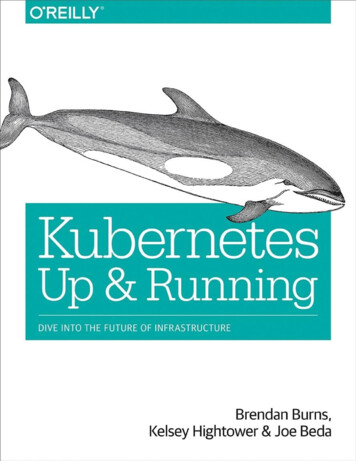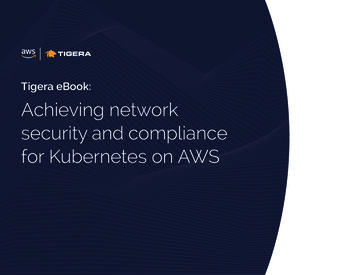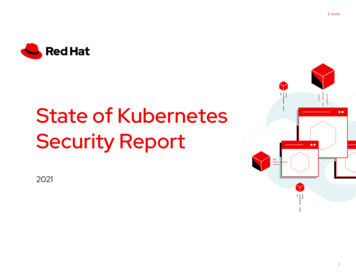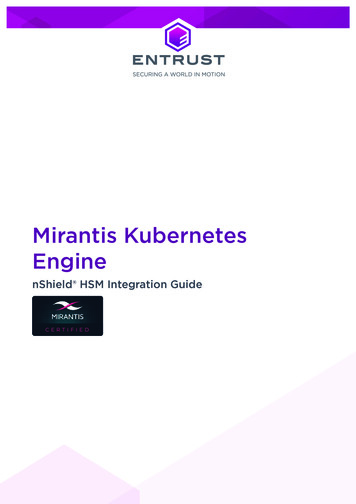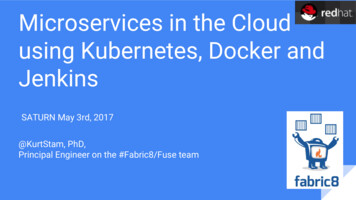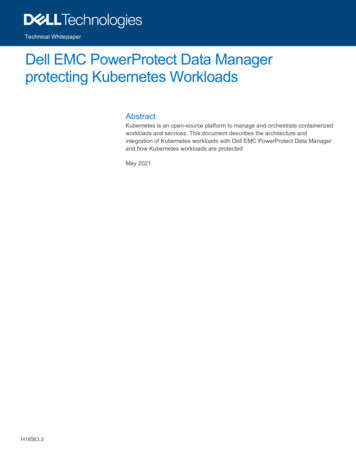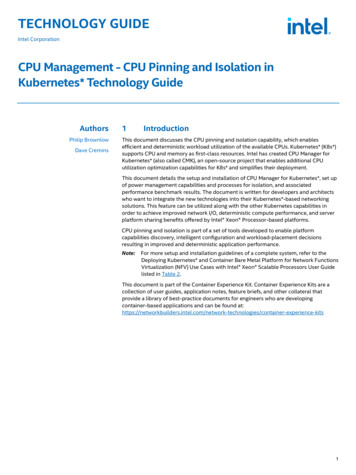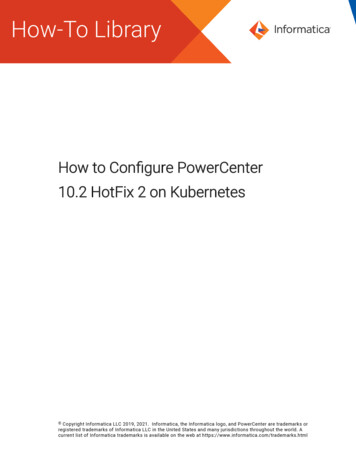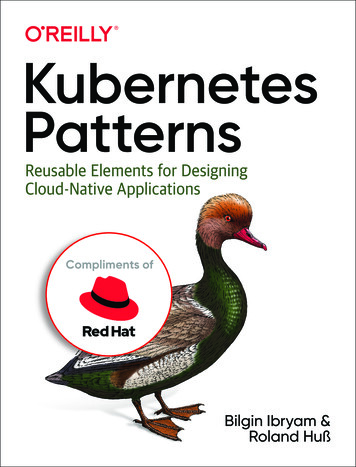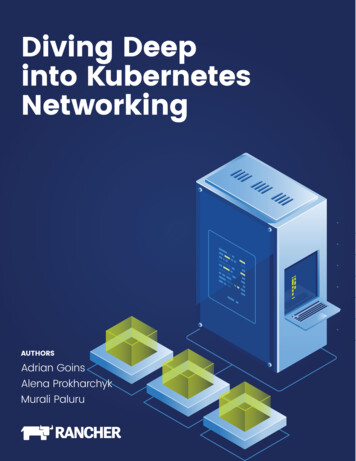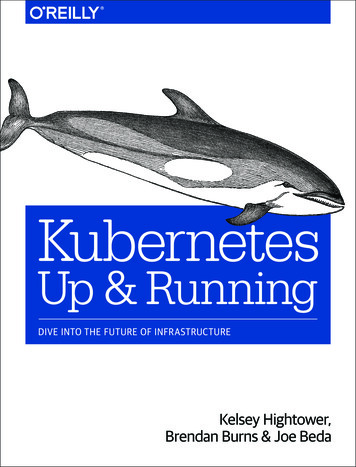
Transcription
KubernetesUp & RunningDIVE INTO THE FUTURE OF INFRASTRUCTUREKelsey Hightower,Brendan Burns & Joe Beda
Kubernetes: Up and RunningDive into the Future of InfrastructureKelsey Hightower, Brendan Burns, and Joe BedaBeijingBoston Farnham SebastopolTokyo
Kubernetes: Up and Runningby Kelsey Hightower, Brendan Burns, and Joe BedaCopyright 2017 Kelsey Hightower, Brendan Burns, and Joe Beda. All rights reserved.Printed in the United States of America.Published by O’Reilly Media, Inc., 1005 Gravenstein Highway North, Sebastopol, CA 95472.O’Reilly books may be purchased for educational, business, or sales promotional use. Online editions arealso available for most titles (http://oreilly.com/safari). For more information, contact our corporate/insti‐tutional sales department: 800-998-9938 or corporate@oreilly.com.Editor: Angela RufinoProduction Editor: Melanie YarbroughCopyeditor: Christina EdwardsProofreader: Rachel HeadSeptember 2017:Indexer: Kevin BroccoliInterior Designer: David FutatoCover Designer: Karen MontgomeryIllustrator: Rebecca DemarestFirst EditionRevision History for the First Edition2017-09-05:2018-02-02:First ReleaseSecond ReleaseSee http://oreilly.com/catalog/errata.csp?isbn 9781491935675 for release details.The O’Reilly logo is a registered trademark of O’Reilly Media, Inc. Kubernetes: Up and Running, the coverimage, and related trade dress are trademarks of O’Reilly Media, Inc.While the publisher and the authors have used good faith efforts to ensure that the information andinstructions contained in this work are accurate, the publisher and the authors disclaim all responsibilityfor errors or omissions, including without limitation responsibility for damages resulting from the use ofor reliance on this work. Use of the information and instructions contained in this work is at your ownrisk. If any code samples or other technology this work contains or describes is subject to open sourcelicenses or the intellectual property rights of others, it is your responsibility to ensure that your usethereof complies with such licenses and/or rights.978-1-491-93567-5[LSI]
For Klarissa and Kelis, who keep me sane. And for my Mom, who taught me a strongwork ethic and how to rise above all odds. —Kelsey HightowerFor my Dad, who helped me fall in love with computers by bringing home punch cardsand dot matrix banners. —Joe BedaFor Robin, Julia, Ethan, and everyone who bought cookies to pay for that Commodore64 in my third-grade class. —Brendan Burns
Table of ContentsPreface. . . . . . . . . . . . . . . . . . . . . . . . . . . . . . . . . . . . . . . . . . . . . . . . . . . . . . . . . . . . . . . . . . . . . . . xi1. Introduction. . . . . . . . . . . . . . . . . . . . . . . . . . . . . . . . . . . . . . . . . . . . . . . . . . . . . . . . . . . . . . . . 1VelocityThe Value of ImmutabilityDeclarative ConfigurationSelf-Healing SystemsScaling Your Service and Your TeamsDecouplingEasy Scaling for Applications and ClustersScaling Development Teams with MicroservicesSeparation of Concerns for Consistency and ScalingAbstracting Your InfrastructureEfficiencySummary234455667910112. Creating and Running Containers. . . . . . . . . . . . . . . . . . . . . . . . . . . . . . . . . . . . . . . . . . . . . 13Container ImagesThe Docker Image FormatBuilding Application Images with DockerDockerfilesImage SecurityOptimizing Image SizesStoring Images in a Remote RegistryThe Docker Container RuntimeRunning Containers with DockerExploring the kuard ApplicationLimiting Resource Usage1414161617171819191920v
CleanupSummary20213. Deploying a Kubernetes Cluster. . . . . . . . . . . . . . . . . . . . . . . . . . . . . . . . . . . . . . . . . . . . . . 23Installing Kubernetes on a Public Cloud ProviderGoogle Container ServiceInstalling Kubernetes with Azure Container ServiceInstalling Kubernetes on Amazon Web ServicesInstalling Kubernetes Locally Using minikubeRunning Kubernetes on Raspberry PiThe Kubernetes ClientChecking Cluster StatusListing Kubernetes Worker NodesCluster ComponentsKubernetes ProxyKubernetes DNSKubernetes UISummary23242425252626262729303030314. Common kubectl Commands. . . . . . . . . . . . . . . . . . . . . . . . . . . . . . . . . . . . . . . . . . . . . . . . . 33NamespacesContextsViewing Kubernetes API ObjectsCreating, Updating, and Destroying Kubernetes ObjectsLabeling and Annotating ObjectsDebugging CommandsSummary333334353536365. Pods. . . . . . . . . . . . . . . . . . . . . . . . . . . . . . . . . . . . . . . . . . . . . . . . . . . . . . . . . . . . . . . . . . . . . . 37Pods in KubernetesThinking with PodsThe Pod ManifestCreating a PodCreating a Pod ManifestRunning PodsListing PodsPod DetailsDeleting a PodAccessing Your PodUsing Port ForwardingGetting More Info with LogsRunning Commands in Your Container with execvi Table of Contents38383940404141424343444444
Copying Files to and from ContainersHealth ChecksLiveness ProbeReadiness ProbeTypes of Health ChecksResource ManagementResource Requests: Minimum Required ResourcesCapping Resource Usage with LimitsPersisting Data with VolumesUsing Volumes with PodsDifferent Ways of Using Volumes with PodsPersisting Data Using Remote DisksPutting It All TogetherSummary45454647474748505051515253546. Labels and Annotations. . . . . . . . . . . . . . . . . . . . . . . . . . . . . . . . . . . . . . . . . . . . . . . . . . . . . 55LabelsApplying LabelsModifying LabelsLabel SelectorsLabel Selectors in API ObjectsAnnotationsDefining AnnotationsCleanupSummary5556585860616262637. Service Discovery. . . . . . . . . . . . . . . . . . . . . . . . . . . . . . . . . . . . . . . . . . . . . . . . . . . . . . . . . . . 65What Is Service Discovery?The Service ObjectService DNSReadiness ChecksLooking Beyond the ClusterCloud IntegrationAdvanced DetailsEndpointsManual Service Discoverykube-proxy and Cluster IPsCluster IP Environment able of Contents vii
8. ReplicaSets. . . . . . . . . . . . . . . . . . . . . . . . . . . . . . . . . . . . . . . . . . . . . . . . . . . . . . . . . . . . . . . . 77Reconciliation LoopsRelating Pods and ReplicaSetsAdopting Existing ContainersQuarantining ContainersDesigning with ReplicaSetsReplicaSet SpecPod TemplatesLabelsCreating a ReplicaSetInspecting a ReplicaSetFinding a ReplicaSet from a PodFinding a Set of Pods for a ReplicaSetScaling ReplicaSetsImperative Scaling with kubectl ScaleDeclaratively Scaling with kubectl applyAutoscaling a ReplicaSetDeleting 85869. DaemonSets. . . . . . . . . . . . . . . . . . . . . . . . . . . . . . . . . . . . . . . . . . . . . . . . . . . . . . . . . . . . . . . 87DaemonSet SchedulerCreating DaemonSetsLimiting DaemonSets to Specific NodesAdding Labels to NodesNode SelectorsUpdating a DaemonSetUpdating a DaemonSet by Deleting Individual PodsRolling Update of a DaemonSetDeleting a DaemonSetSummary8888909091929293949410. Jobs. . . . . . . . . . . . . . . . . . . . . . . . . . . . . . . . . . . . . . . . . . . . . . . . . . . . . . . . . . . . . . . . . . . . . . 95The Job ObjectJob PatternsOne ShotParallelismWork QueuesSummary95969610010210611. ConfigMaps and Secrets. . . . . . . . . . . . . . . . . . . . . . . . . . . . . . . . . . . . . . . . . . . . . . . . . . . . 107ConfigMapsviii Table of Contents107
Creating ConfigMapsUsing a ConfigMapSecretsCreating SecretsConsuming SecretsPrivate Docker RegistriesNaming ConstraintsManaging ConfigMaps and 1311411511611611711711912. Deployments. . . . . . . . . . . . . . . . . . . . . . . . . . . . . . . . . . . . . . . . . . . . . . . . . . . . . . . . . . . . . 121Your First DeploymentDeployment InternalsCreating DeploymentsManaging DeploymentsUpdating DeploymentsScaling a DeploymentUpdating a Container ImageRollout HistoryDeployment StrategiesRecreate StrategyRollingUpdate StrategySlowing Rollouts to Ensure Service HealthDeleting a 13413513613. Integrating Storage Solutions and Kubernetes. . . . . . . . . . . . . . . . . . . . . . . . . . . . . . . . . 137Importing External ServicesServices Without SelectorsLimitations of External Services: Health CheckingRunning Reliable SingletonsRunning a MySQL SingletonDynamic Volume ProvisioningKubernetes-Native Storage with StatefulSetsProperties of StatefulSetsManually Replicated MongoDB with StatefulSetsAutomating MongoDB Cluster CreationPersistent Volumes and StatefulSetsOne Final Thing: Readiness Probes138139141141142145146146147149152153Table of Contents ix
Summary15314. Deploying Real-World Applications. . . . . . . . . . . . . . . . . . . . . . . . . . . . . . . . . . . . . . . . . . 155ParsePrerequisitesBuilding the parse-serverDeploying the parse-serverTesting ParseGhostConfiguring GhostRedisConfiguring RedisCreating a Redis ServiceDeploying RedisPlaying with Our Redis 165A. Building a Raspberry Pi Kubernetes Cluster. . . . . . . . . . . . . . . . . . . . . . . . . . . . . . . . . . . . 167Index. . . . . . . . . . . . . . . . . . . . . . . . . . . . . . . . . . . . . . . . . . . . . . . . . . . . . . . . . . . . . . . . . . . . . . . 175x Table of Contents
PrefaceKubernetes: A DedicationKubernetes would like to thank every sysadmin who has woken up at 3 a.m. to restarta process. Every developer who pushed code to production only to find that it didn’trun like it did on their laptop. Every systems architect who mistakenly pointed a loadtest at the production service because of a leftover hostname that they hadn’t updated.It was the pain, the weird hours, and the weird errors that inspired the developmentof Kubernetes. In a single sentence: Kubernetes intends to radically simplify the taskof building, deploying, and maintaining distributed systems. It has been inspired bydecades of real-world experience building reliable systems and it has been designedfrom the ground up to make that experience, if not euphoric, at least pleasant. Wehope you enjoy the book!Who Should Read This BookWhether you are new to distributed systems or have been deploying cloud-native sys‐tems for years, containers and Kubernetes can help you achieve new levels of velocity,agility, reliability, and efficiency. This book describes the Kubernetes cluster orches‐trator and how its tools and APIs can be used to improve the development, delivery,and maintenance of distributed applications. Though no previous experience withKubernetes is assumed, to make maximal use of the book you should be comfortablebuilding and deploying server-based applications. Familiarity with concepts like loadbalancers and network storage will be useful, though not required. Likewise, experi‐ence with Linux, Linux containers, and Docker, though not essential, will help youmake the most of this book.Why We Wrote This BookWe have been involved with Kubernetes since its very beginnings. It has been trulyremarkable to watch it transform from a curiosity largely used in experiments to axi
crucial production-grade infrastructure that powers large-scale production applica‐tions in varied fields, from machine learning to online services. As this transitionoccurred, it became increasingly clear that a book that captured both how to use thecore concepts in Kubernetes and the motivations behind the development of thoseconcepts would be an important contribution to the state of cloud-native applicationdevelopment. We hope that in reading this book, you not only learn how to build reli‐able, scalable applications on top of Kubernetes, but also that you receive insight intothe core challenges of distributed systems that led to its development.A Word on Cloud-Native Applications TodayFrom the first programming languages, to object-oriented programming, to thedevelopment of virtualization and cloud infrastructure, the history of computer sci‐ence is a history of the development of abstractions that hide complexity andempower you to build ever more sophisticated applications. Despite this, the develop‐ment of reliable, scalable applications is still dramatically more challenging than itought to be. In recent years, containers and container orchestration APIs like Kuber‐netes have become an important abstraction that radically simplifies the developmentof reliable, scalable distributed systems. Though containers and orchestrators are stillin the process of entering the mainstream, they are already enabling developers tobuild and deploy applications with a speed, agility, and reliability that would haveseemed like science fiction only a few years ago.Navigating This BookThis book is organized as follows. The first chapter outlines the high-level benefits ofKubernetes without diving too deeply into the details. If you are new to Kubernetes,this is a great place to start to understand why you should read the rest of the book.The following chapter provides a detailed introduction to containers and container‐ized application development. If you’ve never really played around with Dockerbefore, this chapter will be a useful introduction. If you are already a Docker expert, itwill likely be mostly review.Chapter 3 covers how to deploy Kubernetes. While most of this book focuses on howto use Kubernetes, you need to get a cluster up and running before you start using it.While running a cluster for production is out of the scope of this book, this chapterpresents a couple of easy ways to create a cluster so that you can understand how touse Kubernetes.Starting with Chapter 5, we dive into the details of deploying an application usingKubernetes. We cover Pods (Chapter 5), labels and annotations (Chapter 6), services(Chapter 7), and ReplicaSets (Chapter 8). These form the core basics of what youneed to deploy your service in Kubernetes.xii Preface
After those chapters, we cover some more specialized objects in Kubernetes: DaemonSets (Chapter 9), jobs (Chapter 10), and ConfigMaps and secrets (Chapter 11). Whilethese chapters are essential for many production applications, if you are just learningKubernetes they can be skipped and returned to later, after you gain more experienceand expertise.We then cover deployments (Chapter 12), which tie together the lifecycle of a com‐plete application, and integrating storage into Kubernetes (Chapter 13). Finally, weconclude with some examples of how to develop and deploy real-world applicationsin Kubernetes.Online ResourcesYou will want to install Docker. You likely will also want to familiarize yourself withthe Docker documentation if you have not already done so.Likewise, you will want to install the kubectl command-line tool. You may also wantto join the Kubernetes slack channel, where you will find a large community of userswho are willing to talk and answer questions at nearly any hour of the day.Finally, as you grow more advanced, you may want to engage with the open sourceKubernetes repository on GitHub.Conventions Used in This BookThe following typographical conventions are used in this book:ItalicIndicates new terms, URLs, email addresses, filenames, and file extensions.Constant widthUsed for program listings, as well as within paragraphs to refer to program ele‐ments such as variable or function names, databases, data types, environmentvariables, statements, and keywords.Constant width boldShows commands or other text that should be typed literally by the user.Constant width italicShows text that should be replaced with user-supplied values or by values deter‐mined by context.Preface xiii
This icon signifies a tip, suggestion, or general note.This icon indicates a warning or caution.Using Code ExamplesSupplemental material (code examples, exercises, etc.) is available for download mples.This book is here to help you get your job done. In general, if example code is offeredwith this book, you may use it in your programs and documentation. You do notneed to contact us for permission unless you’re reproducing a significant portion ofthe code. For example, writing a program that uses several chunks of code from thisbook does not require permission. Selling or distributing a CD-ROM of examplesfrom O’Reilly books does require permission. Answering a question by citing thisbook and quoting example code does not require permission. Incorporating a signifi‐cant amount of example code from this book into your product’s documentation doesrequire permission.We appreciate, but do not require, attribution. An attribution usually includes thetitle, author, publisher, and ISBN. For example: “Kubernetes: Up and Running by Kel‐sey Hightower, Brendan Burns, and Joe Beda (O’Reilly). Copyright 2017 Kelsey High‐tower, Brendan Burns, and Joe Beda, 978-1-491-93567-5.”If you feel your use of code examples falls outside fair use or the permission givenabove, feel free to contact us at permissions@oreilly.com.O’Reilly SafariSafari (formerly Safari Books Online) is a membership-basedtraining and reference platform for enterprise, government,educators, and individuals.Members have access to thousands of books, training videos, Learning Paths, interac‐tive tutorials, and curated playlists from over 250 publishers, including O’ReillyMedia, Harvard Business Review, Prentice Hall Professional, Addison-Wesley Profes‐sional, Microsoft Press, Sams, Que, Peachpit Press, Adobe, Focal Press, Cisco Press,xiv Preface
John Wiley & Sons, Syngress, Morgan Kaufmann, IBM Redbooks, Packt, AdobePress, FT Press, Apress, Manning, New Riders, McGraw-Hill, Jones & Bartlett, andCourse Technology, among others.For more information, please visit http://oreilly.com/safari.How to Contact UsPlease address comments and questions concerning this book to the publisher:O’Reilly Media, Inc.1005 Gravenstein Highway NorthSebastopol, CA 95472800-998-9938 (in the United States or Canada)707-829-0515 (international or local)707-829-0104 (fax)We have a web page for this book, where we list errata, examples, and any additionalinformation. You can access this page at http://bit.ly/kubernetes-up-and-running.To comment or ask technical questions about this book, send email to bookques‐tions@oreilly.com.For more information about our books, courses, conferences, and news, see our web‐site at http://www.oreilly.com.Find us on Facebook: http://facebook.com/oreillyFollow us on Twitter: http://twitter.com/oreillymediaWatch us on YouTube: http://www.youtube.com/oreillymediaPreface xv
CHAPTER 1IntroductionKubernetes is an open source orchestrator for deploying containerized applications.Kubernetes was originally developed by Google, inspired by a decade of experiencedeploying scalable, reliable systems in containers via application-oriented APIs.1But Kubernetes is much more than simply exporting technology developed at Google.Kubernetes has grown to be the product of a rich and growing open source commu‐nity. This means that Kubernetes is a product that is suited not just to the needs ofinternet-scale companies but to cloud-native developers of all scales, from a cluster ofRaspberry Pi computers to a warehouse full of the latest machines. Kubernetes pro‐vides the software necessary to successfully build and deploy reliable, scalable dis‐tributed systems.You may be wondering what we mean when we say “reliable, scalable distributed sys‐tems.” More and more services are delivered over the network via APIs. These APIsare often delivered by a distributed system, the various pieces that implement the APIrunning on different machines, connected via the network and coordinating theiractions via network communication. Because we rely on these APIs increasingly forall aspects of our daily lives (e.g., finding directions to the nearest hospital), these sys‐tems must be highly reliable. They cannot fail, even if a part of the system crashes orotherwise fails. Likewise, they must maintain availability even during software roll‐outs or other maintenance events. Finally, because more and more of the world iscoming online and using such services, they must be highly scalable so that they cangrow their capacity to keep up with ever-increasing usage without radical redesign ofthe distributed system that implements the services.1 Brendan Burns et al., “Borg, Omega, and Kubernetes: Lessons Learned from Three Container-ManagementSystems over a Decade,” ACM Queue 14 (2016): 70–93, available at http://bit.ly/2vIrL4S.1
Depending on when and why you have come to hold this book in your hands, youmay have varying degrees of experience with containers, distributed systems, andKubernetes. Regardless of what your experience is, we believe this book will enableyou to make the most of your use of Kubernetes.There are many reasons why people come to use containers and container APIs likeKubernetes, but we believe they effectively all can be traced back to one of these bene‐fits: Velocity Scaling (of both software and teams) Abstracting your infrastructure EfficiencyIn the following sections we describe how Kubernetes can help provide each of thesebenefits.VelocityVelocity is the key component in nearly all software development today. The chang‐ing nature of software from boxed software shipped on CDs to web-based servicesthat change every few hours means that the difference between you and your compet‐itors is often the speed with which you can develop and deploy new components andfeatures.It is important to note, however, that this velocity is not defined in terms of simplyraw speed. While your users are always looking for iterative improvement, they aremore interested in a highly reliable service. Once upon a time, it was OK for a serviceto be down for maintenance at midnight every night. But today, our users expect con‐stant uptime, even if the software they are running is changing constantly.Consequently, velocity is measured not in terms of the raw number of features youcan ship per hour or day, but rather in terms of the number of things you can shipwhile maintaining a highly available service.In this way, containers and Kubernetes can provide the tools that you need to movequickly, while staying available. The core concepts that enable this are immutability,declarative configuration, and online self-healing systems. These ideas all interrelateto radically improve the speed with which you can reliably deploy software.2 Chapter 1: Introduction
The Value of ImmutabilityContainers and Kubernetes encourage developers to build distributed systems thatadhere to the principles of immutable infrastructure. With immutable infrastructure,once an artifact is created in the system it does not change via user modifications.Traditionally, computers and software systems have been treated as mutable infra‐structure. With mutable infrastructure, changes are applied as incremental updates toan existing system. A system upgrade via the apt-get update tool is a good exampleof an update to a mutable system. Running apt sequentially downloads any updatedbinaries, copies them on top of older binaries, and makes incremental updates toconfiguration files. With a mutable system, the current state of the infrastructure isnot represented as a single artifact, but rather an accumulation of incrementalupdates and changes. On many systems these incremental updates come from notjust system upgrades but operator modifications as well.In contrast, in an immutable system, rather than a series of incremental updates andchanges, an entirely new, complete image is built, where the update simply replacesthe entire image with the newer image in a single operation. There are no incrementalchanges. As you can imagine, this is a significant shift from the more traditionalworld of configuration management.To make this more concrete in the world of containers, consider two different ways toupgrade your software:1. You can log into a container, run a command to download your new software,kill the old server, and start the new one.2. You can build a new container image, push it to a container registry, kill the exist‐ing container, and start a new one.At first blush, these two approaches might seem largely indistinguishable. So what isit about the act of building a new container that improves reliability?The key differentiation is the artifact that you create, and the record of how you cre‐ated it. These records make it easy to understand exactly the differences in some newversion and, if something goes wrong, determine what has changed and how to fix it.Additionally, building a new image rather than modifying an existing one means theold image is still around, and can quickly be used for a rollback if an error occurs. Incontrast, once you copy your new binary over an existing binary, such rollback isnearly impossible.Immutable container images are at the core of everything that you will build inKubernetes. It is possible to imperatively change running containers, but this is anantipattern to be used only in extreme cases where there are no other options (e.g., ifit is the only way to temporarily repair a mission-critical production system). AndVelocity 3
even then, the changes must also be recorded through a declarative configurationupdate at some later time, after the fire is out.Declarative ConfigurationImmutability extends beyond containers running in your cluster to the way youdescribe your application to Kubernetes. Everything in Kubernetes is a declarativeconfiguration object that represents the desired state of the system. It is Kubernetes’sjob to ensure that the actual state of the world matches this desired state.Much like mutable versus immutable infrastructure, declarative configuration is analternative to imperative configuration, where the state of the world is defined by theexecution of a series of instructions rather than a declaration of the desired state ofthe world. While imperative commands define actions, declarative configurationsdefine state.To understand these two approaches, consider the task of producing three replicas ofa piece of software. With an imperative approach, the configuration would say: “runA, run B, and run C.” The corresponding declarative configuration would be “replicasequals three.”Because it describes the state of the world, declarative configuration does not have tobe executed to be understood. Its impact is concretely declared. Since the effects ofdeclarative configuration can be understood before they are executed, declarativeconfiguration is far less error-prone. Further, the traditional tools of software devel‐opment, such as source control, code review, and unit testing, can be used in declara‐tive configuration in ways that are impossible for imperative instructions.The combination of declarative state stored in a version control system and Kuberne‐tes’s ability to make reality match this declarative state makes rollback of a changetrivially easy. It is simply restating the previous declarative state of the system. Withimperative systems this is usually impossible, since while the imperative instructionsdescribe how to get you from point A to point B, they rarely include the reverseinstructions that can get you back.Self-Healing SystemsKubernetes is an online, self-healing system. When it receives a desired state configu‐ration, it does not simply take actions to make the current state match the desiredstate a single time. It continuously takes actions to ensure that the current statematches the desired state. This means that not only will Kubernetes initialize yoursystem, but it will guard it against any failures or perturbations that might destabilizeyour system and affect reliability.A more traditional operator repair involves a manual series of mitigation steps, orhuman intervention performed in response to some sort of alert. Imperative repair4 Chapter 1: Introduction
like this is more expensive (since it generally requires an on-call operator to be avail‐able to enact the repair). It is also generally slower, since a human must often wake upand log in to respond. Furthermore, it is less reliable since the imperative series ofrepair operations suffer from all of the problems of imperative managementdescribed in the previous section. Self-healing systems like Kubernetes both reducethe burden on operators and improve the overall reliability of the system by perform‐ing reliable repairs more quickly.As a concrete example of this self-healing behavior, if you assert a desired state ofthree replicas to Kubernetes, it does not just create three replicas—it continuouslyensures that there are exactly three replicas. If you manually create a fourth replicaKubernetes will destroy one to bring the number back to three. If you manuallydestroy a replica, Kubernetes will create one to again return you to the desired state.Online self-healing systems improve developer velocity because the time and energyyou might otherwise have spent on operations and maintenance can instead be spenton developing and testing new features.Scaling Your Service and Your TeamsAs your product grows, its inevitable that you will need to scale both your softwareand the teams that develop it. Fortunately, Kubernetes can help with both of thesegoals. Kubernetes achieves scalability by favoring decoupled architectures.DecouplingIn a decoupled architecture each component is separated from other components bydefined APIs and service load balancers. APIs and load balancers isolate each piece ofthe system from the others. APIs provide a buffer between implementer and con‐sumer, and load balancers provide a buffer between running instances of each ser‐vice.Decoupling components via load balancers makes it easy to scale the programs thatmake up your service, because increasing the size (and therefore the capacity) of theprogram can be done without adjusting or reconfiguring any of the other layers ofyour service.Decoupling servers via APIs make
Kubernetes Up & Running. Kelsey Hightower, Brendan Burns, and Joe Beda Kubernetes: Up and Running Dive into the Future of Infrastructure Beijing Boston Farnham Sebastopol Tokyo. 978-1-491-93567-5 [LSI] Kubernetes: Up and Running by Kelsey Hightower, Brendan Burns, and Joe Beda

